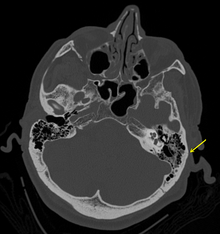Signs and Symptoms and Pathophysiology
- Bruising behind the ears
- Bruising around the eyes
- Blood behind the ear drum
- Cerebrospinal fluid (CSF) leak from the nose or ear
- Cranial nerve palsy
- Basilar skull fractures involve breaks in the posterior or anterior skull base
- Temporal bone fracture is the most common type
- Fractures can occur around the foramen magnum, leading to injury to blood vessels and nerves
- Damage to cranial nerves may result in loss of facial function or hearing loss
- Basilar skull fractures can be life-threatening
Management and Prognosis
- Preventive antibiotics do not provide clinical benefit in preventing meningitis
- Treatment is based on the extent and location of the injury
- Surgery may be required to seal a CSF leak, relieve pressure on a cranial nerve, or repair blood vessel injury
- CT scan is typically used for diagnosis
- Facial fractures often accompany basilar skull fractures
- Non-displaced fractures usually heal without intervention
- Basilar skull fractures increase the risk of meningitis
- The efficacy of prophylactic antibiotics is uncertain
Society and Culture
- Basilar skull fractures are a common cause of death in motor racing accidents
- Several race car drivers have died as a result of basilar skull fractures
- Head and neck restraints, such as the HANS device, are mandated in motorsports to prevent basilar skull fractures
- The HANS device has been proven to save lives in multiple accidents
- Since the implementation of the HANS device, there have been no crash-related fatalities in NASCAR's national divisions
Classification
- ICD-10 code for basilar skull fracture is S02.1
- ICD-9-CM code for basilar skull fracture is 801.1
Causes, Symptoms, Diagnosis, and Treatment
- Trauma to the head
- Motor vehicle accidents
- Falls from a height
- Sports injuries
- Physical assaults
- Headache
- Bruising around the eyes or behind the ears
- Clear fluid leaking from the nose or ears
- Double vision
- Difficulty hearing or ringing in the ears
- Physical examination
- Imaging tests such as CT scan or MRI
- Neurological evaluation
- Evaluation of cerebrospinal fluid (CSF) from the nose or ears
- Evaluation of the patient's medical history and symptoms
- Observation and monitoring for mild cases
- Pain management
- Surgical repair for severe fractures
- Antibiotics to prevent infection
- Rehabilitation and physical therapy to regain function
A basilar skull fracture is a break of a bone in the base of the skull. Symptoms may include bruising behind the ears, bruising around the eyes, or blood behind the ear drum. A cerebrospinal fluid (CSF) leak occurs in about 20% of cases and may result in fluid leaking from the nose or ear. Meningitis occurs in about 14% of cases. Other complications include injuries to the cranial nerves or blood vessels.
| Basilar skull fracture | |
|---|---|
| Other names | Basal skull fracture, skull base fractures |
 | |
| A subtle temporal bone fracture as seen on a CT scan | |
| Specialty | Emergency medicine, neurosurgery |
| Symptoms | Bruising behind the ears, bruising around the eyes, blood behind the ear drum |
| Complications | Cerebrospinal fluid leak, facial fracture, meningitis |
| Types | Anterior, central, posterior |
| Causes | Trauma |
| Diagnostic method | CT scan |
| Treatment | Based on injuries inside the skull |
| Frequency | ≈12% of severe head injuries |
A basilar skull fracture typically requires a significant degree of trauma to occur. It is defined as a fracture of one or more of the temporal, occipital, sphenoid, frontal or ethmoid bone. Basilar skull fractures are divided into anterior fossa, middle fossa and posterior fossa fractures. Facial fractures often also occur. Diagnosis is typically by CT scan.
Treatment is generally based on the extent and location of the injury to structures inside the head. Surgery may be performed to seal a CSF leak that does not stop, to relieve pressure on a cranial nerve or repair injury to a blood vessel. Prophylactic antibiotics do not provide a clinical benefit in preventing meningitis. A basilar skull fracture occurs in about 12% of people with a severe head injury.